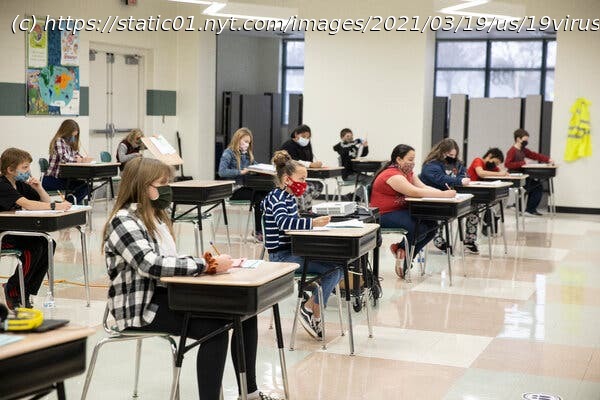The previous recommendation of six feet of distancing was a major obstacle to bringing students back for in-person learning.
In a major policy revision intended to encourage more schools to welcome students back full time, the Centers for Disease Control and Prevention said on Friday that elementary school students and some middle and high school students could be spaced three feet apart in classrooms, as long as everyone was wearing a mask. Previously, the C.D.C. had recommended that schools keep students six feet apart except at the lowest levels of community transmission, a standard that in many districts became a major obstacle to welcoming students back for full-time instruction. In many districts, particularly in Democratic-leaning states, teachers’ unions have used the six-foot guidance to oppose bringing children back for normal schedules. On Friday, an array of public health experts, as well as many parents, applauded the new C.D.C. guidance, saying it would provide important support to districts looking to expand in-person teaching. Many experts say that a growing body of research shows that six feet is not significantly more protective than three, as long as other safety measures are in place. “The reality is that the biggest barrier to getting kids back in school was this question of three versus six feet,” said Dr. Westyn Branch-Elliman, an infectious-disease specialist at the VA Boston Healthcare System, and an author of a recent paper that found little benefit in maintaining six feet of distance provided there was universal mask-wearing. The new guidance seemed to be having an immediate impact in some places. New York City, the nation’s largest school district, announced on Friday that it would give families another chance to select in-person instruction for their children. The city said that elementary schools, prekindergarten programs and programs for children with complex disabilities would move to three-foot distancing in April, while it would review distancing rules for middle and high school students. In Anne Arundel County, Md., where schools are just now reopening for students to attend two days a week, the president of the Board of Education said the new guidance would make it easier for the district to achieve the superintendent’s goal of getting students on a four-day-a-week schedule before the end of the year. “It was a real challenge to be able to bring students back four days with a six-foot distance requirement,” the board president, Melissa Ellis, said. She added there had been confusion over whether the previous guidance actually required six feet of distance in all circumstances. “Now we no longer need to decipher the guidance because it’s much more clear,” Ms. Ellis said. In Texas, Pedro Martinez, the superintendent of the San Antonio Independent School District, called the new guidance “a game changer.” In weighing when and how to bring more students back to classrooms in his district, he added, “My biggest hesitation has been the social distancing requirements.” Still, there was ample evidence that the new guidance would not be enough to push some districts, particularly on the West Coast, to return to anything like a normal school week soon. The concerns of teachers’ unions’ seem likely to pressure some districts to delay returning classrooms to greater density. In Los Angeles, the nation’s second-largest system, district and union leaders agreed this month to allow students to return to classrooms for a mixture of in-person and remote learning starting in April.






